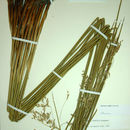Description
(
Inglês
)
fornecido por eFloras
Herbs, perennial, 10--20 dm. Rhizomes long- creeping. Culms erect, 2--5 mm diam. Cataphylls several. Leaves: blade absent. Inflorescences lateral, many flowered, loose; primary bract barely exceeding to many times longer than inflorescence. Flowers variously pedicellate; bracteoles membranous; tepals greenish to pale brown, lanceolate, 3.5--5 mm; inner series loosely subtending capsule at maturity, usually slightly shorter, margins scarious to clear, acutish; stamens 6, filaments 0.3--0.9 mm, anthers 1--2.5 mm; style 1--1.5 mm. Capsules dark brown, 3-locular, oblate to narrowly ovoid, 3--4 mm, nearly equal to perianth. Seeds dark amber, oblate to ellipsoid, 0.5--0.8 mm.
- licença
- cc-by-nc-sa-3.0
- direitos autorais
- Missouri Botanical Garden, 4344 Shaw Boulevard, St. Louis, MO, 63110 USA
Flowering/Fruiting
(
Inglês
)
fornecido por eFloras
Flowering and fruiting summer.
- licença
- cc-by-nc-sa-3.0
- direitos autorais
- Missouri Botanical Garden, 4344 Shaw Boulevard, St. Louis, MO, 63110 USA
Habitat
(
Inglês
)
fornecido por eFloras
Moist or wet exposed areas; 100--1800m.
- licença
- cc-by-nc-sa-3.0
- direitos autorais
- Missouri Botanical Garden, 4344 Shaw Boulevard, St. Louis, MO, 63110 USA
Synonym
(
Inglês
)
fornecido por eFloras
Juncus lesueurii Bolander var. elatus S. Watson
- licença
- cc-by-nc-sa-3.0
- direitos autorais
- Missouri Botanical Garden, 4344 Shaw Boulevard, St. Louis, MO, 63110 USA
Juncus textilis
(
Inglês
)
fornecido por wikipedia EN
Juncus textilis is a species of rush known by the common name basket rush. It is endemic to California, where it grows along the coast and in the coastal mountain ranges of the southern half of the state.[1]
Description
Juncus textilis is a rhizomatous perennial herb growing to a maximum height between 1–2 metres (3.3–6.6 ft). The stems are cylindrical with faint longitudinal grooves. The leaves lack blades and appear as small brown sheaths around the base of the stems.
The long, bushy inflorescence arises from the side of the stem and splits into long branches bearing clusters of many flowers. Each flower is cupped by small, clear bractlets and has pointed greenish brown tepals. There are six stamens with large anthers. The fruit is a dark brown, shiny capsule.
Uses
This species of rush has been used historically for basket weaving by several Native American peoples of southern California, such as the Cahuilla, Kumeyaay, and Chumash, among others.[2]
Juncus textilis is an important plant endemic to California; Chumash people use it today for basket-making as they have been for centuries.[3]
The rush was [sic] valued for its varied colors, from deep red to sun-dried tan; the stems were [sic] dyed black with sea plants such as Suaeda species and yellow with Psorothamnus emoryi.[2][3]
The tassels atop the rushes can be shaken for seeds, which can be eaten like grains. In springtime, the tender white bases can be eaten as emergency rations.[4]
References

- licença
- cc-by-sa-3.0
- direitos autorais
- Wikipedia authors and editors
Juncus textilis: Brief Summary
(
Inglês
)
fornecido por wikipedia EN
Juncus textilis is a species of rush known by the common name basket rush. It is endemic to California, where it grows along the coast and in the coastal mountain ranges of the southern half of the state.
- licença
- cc-by-sa-3.0
- direitos autorais
- Wikipedia authors and editors
Juncus textilis
(
Vietnamita
)
fornecido por wikipedia VI
Juncus textilis là một loài thực vật có hoa trong họ Juncaceae. Loài này được Buchenau mô tả khoa học đầu tiên năm 1903.[1]
Chú thích
Liên kết ngoài
- licença
- cc-by-sa-3.0
- direitos autorais
- Wikipedia tác giả và biên tập viên
Juncus textilis: Brief Summary
(
Vietnamita
)
fornecido por wikipedia VI
Juncus textilis là một loài thực vật có hoa trong họ Juncaceae. Loài này được Buchenau mô tả khoa học đầu tiên năm 1903.
- licença
- cc-by-sa-3.0
- direitos autorais
- Wikipedia tác giả và biên tập viên

